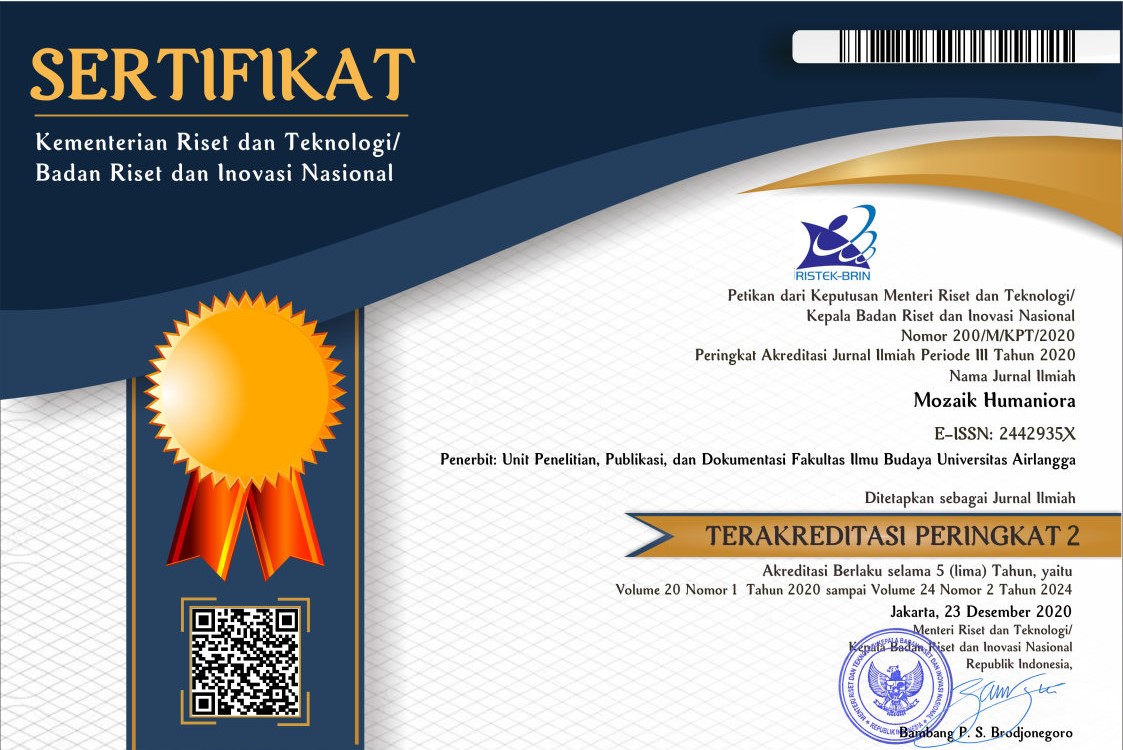Semantic adaptations of the Arabic loanwords in the Indonesian language
Downloads
Abdullah, A., Wekke, I. S., & Barat, P. (2018).Origins of Islam in Indonesia. International journal of pure and applied mathematics 1. 119(18), 1149–1179.
Akhbar Dirburun (2018). Alharisah Alati tugam fi yaum alashir min muharam. Retrieved from https://www.dearborn.org/ar/archives/27458/.
Akidah, M. A. (2013). Phonological and Semantic Change in Language Borrowing (The Case of Arabic Words Borrowed into Kiswahili). International Journal of Education and Research, 1(4), 1-20."
Almaani dictionary online. (2019). Retrieved from https://www.almaany.com/ar/dict/ar-ar/ & https://www.almaany.com/en/dict/ar-en/العهن/
Anwar, F. (2017). Semantic Change in Language Borrowing: The Case of Arabic Borrowed Words in Urdu. Language in India. 17(2) 107-124.
Bahumaid, S. (2015). Lexical Borrowing: The Case of English Loanwords in Hadhrami Arabic. International Journal of Language and Linguistics, 2(6), 13-24."
Danzaki, M. (2015). Semantic change in Arabic loanwords in Hasua. The-Proceeding of the 2nd International Conference on Arabic Studies and Islamic Civilization. Kuala Lumpur, Malaysia.
De Saussure, F. (1916). Course in General Linguistics. NY, USA: Columbia University Press.
Devianty, R. (2016). Loanwords in Indonesia. Vision, 9 (9).
Hardini, T. I., & Grangé, P. (2016). An overview of Indonesian loanwords from French. Indonesian Journal of Applied Linguistics, 6(1), 155-171."
Hasan, M. (2015). Semantic change of words entered into another language through the process of language borrowing: A case study of Arabic words in Bengali. PEOPLE: International Journal of Social Sciences, 1(1)." 1375:1390.
Hashemi, E. S. (2014). Phonological Adaptation of Arabic Loan Words in Persian: Consonants. International Journal and Humanities and Social Science, 4(6), 1." 225-236.
Haspelmath, M. & Tadmor, U. (2009). Loanwords in the World's Languages : A comparative handbook. Berlin,Germany : Walter Wiegand.H.
Hickey,R.(2010).The handbook of language Contact. Singapore : Blackwell Publishing.
Hoffer, B. L. (2002). Language borrowing and language diffusion: An overview. Intercultural communication studies, 11(4), 1-37."
Indonesian mixed corpus collection (2013) retrieved from https://corpora.uni- leipzig.de/en/res?word=daftar&corpusId=ind_mixed_2013
Jones, R. (1984). Loan-words in contemporary Indonesian. JWM Verhaar (Ed.)."Retrieved from http://sealang.net/archives/nusa/pdf/nusa-v19-p1-38.pdf
Kamus Besar Bahasa Indonesia(5thed)online.(2019) version 2.5. Retrieved from https://www.kbbi.web.id/
Khan, I.A. (2014). Lexical borrowings from Arabic and Semantic change in Urdu: A cross linguistic analysis. Hope Journal of Research, 2(3) 47-66.
Khrisat, A., & Mohammad, M. S. (2014). Language's borrowings: The role of the borrowed and Arabized words in enriching Arabic language. American Journal of Humanities and Social Sciences, 2(2), 133-142."
Koin (Korpus Indonesia) (2018). Badan Pengembangan dan Pembinaan Bahasa, Kementerian Pendidikan dan Kebudayaan Republik Indonesia retrieved from https://korpusindonesia.kemdikbud.go.id/index.php?r=/site/sentences
Lubat aldabus -Almuritaniah (2019) . Ragsah shabiyah yihadidaha alihmal alrasmi bilindithar Retrieved from https://www.alaraby.co.uk/society/2019/2/10/
Matras, Y.(2009). Language contact. NY, USA: Cambridge University Press.
Miller, R.(2015). Trask's Historical Linguistics, (3rd,ed ).NY,USA: Routledge.
Murphy, L. & Koskela, A. (2010). Key terms in semantics. NY,USA : Continuum.
Oxford Dictionaries Online. (2019). Retrieved from https://id.oxforddictionaries.com/
Pavlou,P.Y. (1993). The semantic adaptation of Turkish loanwords in Cypriot-Greek. The First International Conference on Greek Linguistics. Reading, United Kingdom
Sapir. E. (1921). Language : An introduction to the study of Speech, Taipei: Rainbow-Bridge.
Shariq, M. (2013). Exploring the semantic changes in Persian loan words: Used in Brass Industry of Moradabad. Language in India ,13(3) 371-380.
Stanzy, P. (2005). Encyclopedia of linguistics. New York :Taylor & Francis Group.
Stevens,A.& Schmidgall-Telling, A.(2010). A comprehensive Indonesian -English dictionary, (2nd ed ). USA: Ohio University Press.
Takamura, H., Nagata, R., & Kawasaki, Y. (2017). Analyzing semantic change in Japanese loanwords. In Proceedings of the 15th Conference of the European Chapter of the Association for Computational Linguistics: Volume 1, Long Papers (pp. 1195-1204)." Valencia, Spain.
Thomason, S. G., & Kaufman, T. (2001). Language contact. Edinburgh: Edinburgh University Press."
Torstensson, B. (2014). Semantic change in words loaned to Swedish : A Comparison of metonymy and metaphor (Bachelor Thesis).Lund University.
Traore,M. & Natalia, S. (2016). Niger-Congo borrowings to English: Semantic changes and grammatical adaptation. Journal of English and Literature,2(2) 12-22.
Trauth, G. & Kazzazi, K. (2006). Routledge Dictionary of Language and Linguistics. London, Britain : Routledge.
Van Dam, N. (2010). Arabic loanwords in Indonesian revisited. Bijdragen tot de taal-, land-en volkenkunde/Journal of the Humanities and Social Sciences of Southeast Asia, 166(2-3), 218-243."
Waladabah, M. (2019) The Muritanian Dabus Game. Retrieved from https://www.alaraby.co.uk/society/2019/2/10/لعبة-الدبوس-الموريتانية-رقصة-شعبية-يهددها-الإهمال-الرسمي-بالاندثار
Wiegand,H.(2004). Sociolinguistics, (2nd ed ). Berlin, Germany: Walter Wiegand.
Zaidan, N. A., Zailaini, M. A., & Ismail, W. M. (2015). Absorption of Arabic words in Malay language. OIDA International Journal on Sustainable Development, 8(6), 51-58."

Mozaik Humaniora is licensed under a Creative Commons Attribution-ShareAlike 4.0 International License. Both authors and Mozaik Humaniora agree with the following attribution of journal:
1. Copyright of this journal is possession of Author, by the knowledge of the Editorial Board and Journal Manager, while the moral right of the publication belongs to the author.
2. The journal allows the author(s) to retain publishing rights without restrictions
3. The legal formal aspect of journal publication accessibility refers to Creative Commons Attribution Share-Alike (CC BY-SA).
4. The Creative Commons Attribution Share-Alike (CC BY-SA) license allows re-distribution and re-use of a licensed work on the conditions that the creator is appropriately credited and that any derivative work is made available under "the same, similar or a compatible license”. Other than the conditions mentioned above, the editorial board is not responsible for copyright violation.


















